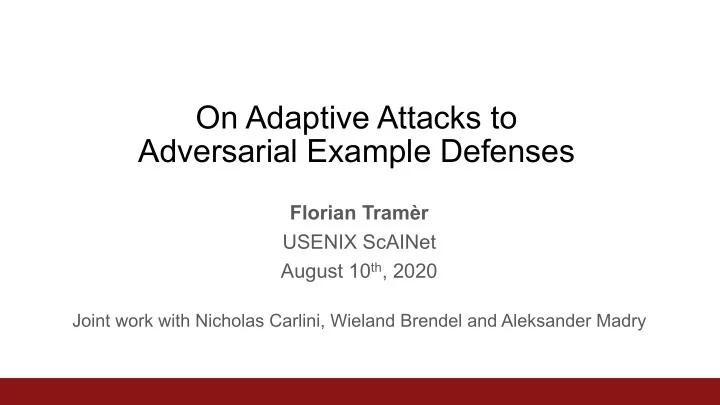

On Adaptive Attacks to Adversarial Example Defenses Florian Tramèr USENIX ScAINet August 10 th , 2020 Joint work with Nicholas Carlini, Wieland Brendel and Aleksander Madry
What Are Adversarial Examples? 88% Tabby Cat 99% Guacamole Biggio et al., 2014 Szegedy et al., 2014 Goodfellow et al., 2015 2
Why Should We Care? ML in security-critical applications Malware Anti phishing Ad-blocking Content takedown detection Understanding robustness under (standard) distribution shift Recht et al., 2019 3
Many Defenses Have Been Proposed... https://nicholas.carlini.com/writing/2019/all-adversarial-example-papers.html 4
...But Evaluating Them Properly Is Hard We re-evaluated 13 defenses presented at [ ICLR | ICML | NeurIPS ] [ 2018 | 2019 | 2020 ] All defenses claim to follow the best evaluation standards Yet, we circumvent all of them ⇒ reduce accuracy to baseline (usually 0%) in the considered threat model 5
Isn’t This Old News? Broke 10 (mainly unpublished) defenses in 2017 Broke 7 defenses published at ICLR 2018 6
Why We Hoped Things Might Have Changed Consensus on what constitutes a good evaluation Clearly defined threat model Adaptive 1. White-box: adversary has access Adversary tailors the to defense parameters attack to the defense Carlini & Wagner, 2017, 2. Small perturbations : Athalye et al., 2018, find 𝑦’ s.t. 𝑦’ misclassified Carlini et al. 2019, ... and ∥ 𝑦 − 𝑦’ ∥ ! ≤ ε Incomplete definition Easy to formalize Surprisingly hard 7
Evaluation Standards Seem To Be Improving Athalye et al. 2018 T et al. 2020 Carlini & Wagner 2017 (7 defenses) (13 defenses) (10 defenses) • Some white-box • All white-box • All white-box • 0/10 adaptive • 2/7 adaptive • 9/13 adaptive • 13/13 with code! Authors (and reviewers) are aware of the importance of adaptive attacks in evaluations 8
Then Why Are Defenses Still Broken? Many defenses are not evaluated against a strong adaptive attack 9
Our Work 13 case studies on how to design strong(er) adaptive attacks Including: • Our hypotheses when reading each defense’s paper/code • Things we tried but that didn’t work • Some things we didn’t try but might also have worked 10
How (not) to build & evaluate defenses 11
Don’t Intentionally Obfuscate Gradients If this wasn’t enough... this won’t be either Breaking specific attack techniques is not the way forward 12
Don’t Blindly Re-use Prior (Adaptive) Attacks Adaptive attack strategies are not universal! Most popular “victims”: BPDA & EOT (Athalye et al. 2018) • Understand why an attack worked on other defenses before re-using it • Use BPDA as a last resort (try gradient-free / decision-based attacks first) • Before using EOT, build an attack that works for fixed randomness 13
Don’t Complicate The Attack Many proposed defenses are complicated (for some reasons, this is particularly true for AdvML papers in security conferences) This is OK! Maybe the best defense has to be complex (randomized) Anomaly detector ... preprocessing (non-differentiable) Multiple components 14
Don’t Complicate The Attack Many proposed defenses are complicated (for some reasons, this is particularly true for AdvML papers in security conferences) This is OK! Maybe the best defense has to be complex But attacks don’t have to be! • Optimizing over complex defenses can be hard ( ℒ = 𝜇 1 ℒ 1 + 𝜇 2 ℒ 2 + 𝜇 3 ℒ 3 + … ) • Evaluate each component individually, there is often a weak link • Combining broken components rarely works 15
Don’t Complicate The Attack Use feature adversaries (Sabour et al. 2015) to break multiple components at once Guac OK Anomaly detector Guac OK Anomaly detector 16
Don’t Convince Reviewers, Convince Yourself! Really try to break your defense (others probably will...) • An evaluation against 10 non-adaptive attacks isn’t broad • If offered $1M to break your defense, would you use a non-adaptive attack? • What assumptions/invariants does the defense rely on? Attack those! Evaluation guidelines are great, but: • Not just a check-list to appease reviewers • They also apply to adaptive attacks (e.g., adaptive attacks should never perform worse than non-adaptive ones) 17
My Defense Got Broken. Now What? 18
My Defense Got Broken. Now What? ~40 white-box defenses that were publicly broken (that I know of) • one paper was retracted before publication • one paper was amended on arXiv We should do better! • Hard to navigate the field for newcomers • Many ideas get re-used despite being broken 19
My Defense Got Broken. Now What? Personal experience: • Often referenced as an effective defense against black-box attacks • Later work developed much stronger transfer attacks L Þ Please contact authors when you find an attack! After intro, or in abstract, results, etc. 20
Conclusion Evaluating adversarial examples defenses is hard! How do we improve things? Resisting attacks that broke prior defenses ≠ progress Ideal: defense evaluation = 99% adaptive attacks • Try breaking other defenses before attacking your own • Strive for simple attacks (and defenses if possible) • We need more independent re-evaluations • If a defense is broken, acknowledge the attack, amend the paper, and keep going! tramer@cs.stanford.edu https://arxiv.org/abs/2002.08347 21
Recommend
More recommend